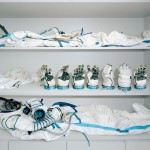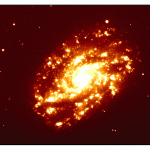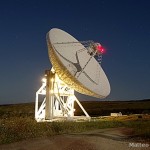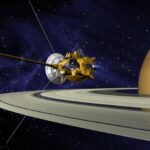After the particle physics degree
Physicist Meghan Anzelc is just as surprised as anyone she wound up with an enjoyable career in the insurance industry.
Figuring out insurance rates and conducting particle physics research are more similar than one might expect. Both depend on interpreting complicated data using high-level mathematical analysis.
For particle physicist Meghan Anzelc, that overlap helped her transition from newly minted PhD to insurance cost analyst.
Today, as an assistant vice president at CNA in Chicago, Anzelc trains her group to use programming language and database tools to predict insurance pricing for small-business clients. She says the job requires her to use many of the skills she learned in her undergraduate and graduate physics work—data manipulation, critical and analytical thinking, and working as a team.
A research trajectory
Anzelc says she didn’t exactly mean to go into particle physics. Interested in just a taste of the science, she signed up for a physics class while enrolled at Loyola University in Chicago. She registered for the class for majors by mistake.
But it turned out that Anzelc enjoyed the material enough to major in physics on purpose.
Over the three summers after she decided to study physics, she discovered her interest in research during internships at Fermi National Accelerator Laboratory and Argonne National Laboratory. “I liked the idea that you could collect data, and do analysis, and learn something about the world that nobody else knew before,” she says.
Anzelc pursued a doctorate in experimental high-energy physics at Northwestern University. She joined Fermilab’s DZero experiment and did her dissertation research on a type of particle decay that could be related to the matter-antimatter imbalance in our universe.
Although she loved research, Anzelc recognized during her doctoral program that she was not interested in a career in academia. She began talking to physicists who had gone into industry.
A friend introduced her to someone who also studied physics but switched to a career as a predictive modeler at Travelers Insurance.
“He could talk to me about how the skills translated, what he found challenging, what he liked about the work,” she says. “It was not a field or an industry that I had any awareness of, but it turned out it was a really good fit.”
To the private sector
After graduating with her doctorate in 2008, Anzelc joined a department at Travelers Insurance that focused on predictive modeling for personal policies such as automobile, home and renters insurance. Her analyses took into account a variety of inputs. For example, for automobile insurance, she considered: Where does the consumer live? What kind of car does the consumer drive? What is the consumer’s credit score? How many years of driving experience does the consumer have?
Her objective was to predict the likelihood that the consumer would get into an accident while insured with the company.
“You’re essentially trying to predict the future using historical information,” Anzelc says.
In 2011, Anzelc left Travelers and joined CNA.
CNA's Vice President of Analytic Data Management Chuck Boucek praises Anzelc’s ability to incorporate information from many different sources. Over time the insurance industry has incorporated increasingly sophisticated models, he says. “Being able to separate what is information and what is noise in all of that data is a key skillset.”
After nearly three years as a predictive modeler at CNA, Anzelc moved to her current managing position. While she doesn’t write the code or query the data anymore, she manages a team that does.
Her main goals, she says, are to help her staff get rid of obstacles and make sure the group is moving forward.
Even in her new position, her past in particle physics is helping her out. She says managing her team members and communicating across ranks and departments require the same skills she needed to work on a collaboration with hundreds of fellow scientists at Fermilab.
Great ways to Cut back Terrorism
Great ways to Cut back Terrorism
Extremism and terrorism has been a expanding risk from the comprehensive countries worldwide. No state presently would seem comfortable at the disposal of terrorists in such a way or any other. Destinations like Pakistan have actually been most influenced by the building terrorism which contains crippled the economic crisis of such a location. All civilized cities inside the worlds are deeply wary of the increasing terrorism everywhere and currently anyone appears to be worried how to manage the developing terrorism.click
Several efforts are simply being developed to take away terrorism but apparently as a substitute for visiting a conclusion it can be ever-increasing every day and more and more folks are getting to be patients thanks to terrorism. Extremism and terrorism are scattering like a most cancers all roughly over the world. The subject comes into play head as why this menace is growing without having to traveling to an end and a few of the objectives using the terrorists organizations. The terrorists appear to be focussed and identified to destabilize any nation except if of course their nefarious concepts are met up with and exactly what they the truth is want with the society specially with the Developed places.
Not surprisingly there are many reasons that generate the expanding terrorism and there is a must find the main reasons for this developing risk to save our world and in order to protect our then development from becoming people in the hands of terrorism. Continue reading
Moda spaziale: passerella da microgravità
 Quattro accademie internazionali di Haute Couture lavorano al guardaroba 2.0 degli astronauti dell’Agenzia Spaziale Europea e guardano al futuro della moda, fra ricadute della ricerca scientifica e wearable technology. Con passerella d’eccezione al Science Museum di Londra Continue reading
Quattro accademie internazionali di Haute Couture lavorano al guardaroba 2.0 degli astronauti dell’Agenzia Spaziale Europea e guardano al futuro della moda, fra ricadute della ricerca scientifica e wearable technology. Con passerella d’eccezione al Science Museum di Londra Continue reading
Supernova con buco nero nella Fenice
 Un team di ricercatori, molti dei quali dell'INAF, presenta i risultati di un lungo e accurato studio su una supernova esplosa quasi 20 anni fa, ricostruendone in dettaglio la sua evoluzione. Stefano Benetti (INAF): «Potremmo aver osservato per la prima volta la fine di una stella massiccia, altrimenti destinata ad una fine oscura ed anonima. Ora nella zona dell'esplosione ci dovrebbe essere un buco nero avente una massa di circa 7-8 masse solari» Continue reading
Un team di ricercatori, molti dei quali dell'INAF, presenta i risultati di un lungo e accurato studio su una supernova esplosa quasi 20 anni fa, ricostruendone in dettaglio la sua evoluzione. Stefano Benetti (INAF): «Potremmo aver osservato per la prima volta la fine di una stella massiccia, altrimenti destinata ad una fine oscura ed anonima. Ora nella zona dell'esplosione ci dovrebbe essere un buco nero avente una massa di circa 7-8 masse solari» Continue reading
Grande successo per Light in Astronomy
 Laboratori aperti, conferenze, spettacoli e osservazioni all'insegna della luce dall'8 al 15 novembre nelle strutture INAF. Hanno partecipato complessivamente più di 6.500 persone - tra le quali numerosissimi studenti - alla settimana “Light in Astronomy" ideata l’Istituto Nazionale di Astrofisica per celebrare l'Anno Internazionale della Luce, nell'ambito del progetto PDIN INAF "From Astronomical light to public enlightment (trough public outreach and education programs)". Continue reading
Laboratori aperti, conferenze, spettacoli e osservazioni all'insegna della luce dall'8 al 15 novembre nelle strutture INAF. Hanno partecipato complessivamente più di 6.500 persone - tra le quali numerosissimi studenti - alla settimana “Light in Astronomy" ideata l’Istituto Nazionale di Astrofisica per celebrare l'Anno Internazionale della Luce, nell'ambito del progetto PDIN INAF "From Astronomical light to public enlightment (trough public outreach and education programs)". Continue reading
Il debutto del gigante
 Completata la prima fase di sviluppo del Sardinia Radio Telescope, si apre per la prima volta alla comunità scientifica. E' appena uscita infatti la primissima “Call for proposals” di SRT Continue reading
Completata la prima fase di sviluppo del Sardinia Radio Telescope, si apre per la prima volta alla comunità scientifica. E' appena uscita infatti la primissima “Call for proposals” di SRT Continue reading
Quella giovane galassia lontana lontana
 Si chiama Tayna e si tratta di una galassia giovane esistita 400 milioni di anni dopo il Big Bang. Una scoperta incredibile che è stata ottenuta grazie ad una collaborazione spaziale tra due dei principali telescopi della NASA che ha permesso di individuare, attraverso il fenomeno della lente gravitazionale, l’oggetto più debole mai osservato nell’Universo primordiale. I risultati di questo studio sono riportati su Astrophysical Journal Continue reading
Si chiama Tayna e si tratta di una galassia giovane esistita 400 milioni di anni dopo il Big Bang. Una scoperta incredibile che è stata ottenuta grazie ad una collaborazione spaziale tra due dei principali telescopi della NASA che ha permesso di individuare, attraverso il fenomeno della lente gravitazionale, l’oggetto più debole mai osservato nell’Universo primordiale. I risultati di questo studio sono riportati su Astrophysical Journal Continue reading
Saturno: bye bye ioni d’acqua
 Ecco come il sesto pianeta del Sistema solare ha perso gli ioni d'acqua presenti nella magnetosfera, cioè il plasma intrappolato nello spazio attorno al pianeta dal suo campo magnetico Continue reading
Ecco come il sesto pianeta del Sistema solare ha perso gli ioni d'acqua presenti nella magnetosfera, cioè il plasma intrappolato nello spazio attorno al pianeta dal suo campo magnetico Continue reading


